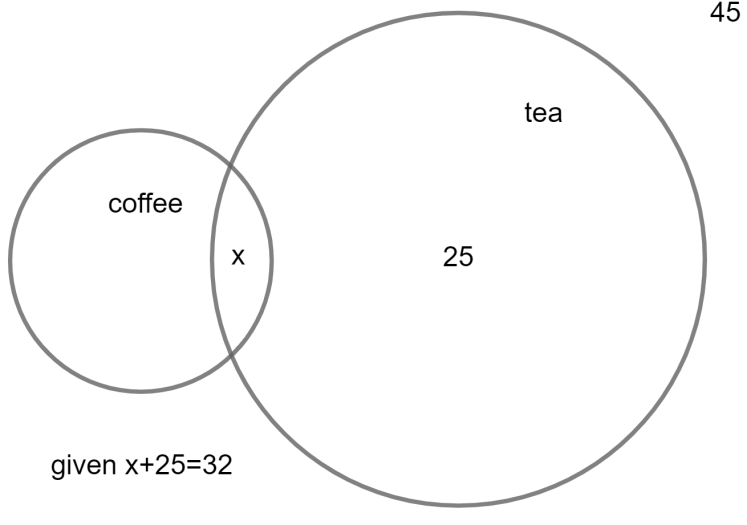
In a group of $45$ persons, $25$ drink tea but not coffee, while $32$ drink tea. How many people drink coffee but not tea?
(A) $12$
(B) $13$
(C) $15$
(D) $20$
Answer
213.6k+ views
Hint: For answering this question we will find the total number of persons who drink coffee but not tea from the given information that is the total number of people present is $45$ and the total number of people who drink tea is $32$. So if we subtract the total number of people who drink tea from the total number of people present we will have the total number of people who drink coffee but not tea.
Complete step-by-step solution:
Now considering the question we have the information stating the total number of persons present in the group is $45$ and the number of persons who drink tea but not coffee is $25$ and the total number of people who drink tea is $32$.
Let us assume the number of people who drink both coffee and tea at $x$.
Then we will have a Venn diagram representing this information as follows:

And now we can derive the number of people who drink both coffee and tea assumed as $x$ and tea by subtracting the number of people who drink tea but not the coffee that is given as $25$ from the total number of people who drink tea which is given as $32$ this can be given mathematically as
$\begin{align}
& x=32-25 \\
& \Rightarrow x=7 \\
\end{align}$ .
Since we have the total number of people present is $45$ and the total number of people who drink tea is $32$ so the number of people who drink coffee only will be $45-32=13$.
Therefore we can conclude that the total number of persons who drink coffee but not tea is $13$.
Hence option B is correct.
Note: While answering questions of this type we should take care of the calculations. If we had made a mistake during the calculations and taken the difference between the total number of people present that is $45$ and the total number of people who drink tea that is $32$ as $45-32=12$ which will imply us to mark option A as correct which is wrong.
Complete step-by-step solution:
Now considering the question we have the information stating the total number of persons present in the group is $45$ and the number of persons who drink tea but not coffee is $25$ and the total number of people who drink tea is $32$.
Let us assume the number of people who drink both coffee and tea at $x$.
Then we will have a Venn diagram representing this information as follows:

And now we can derive the number of people who drink both coffee and tea assumed as $x$ and tea by subtracting the number of people who drink tea but not the coffee that is given as $25$ from the total number of people who drink tea which is given as $32$ this can be given mathematically as
$\begin{align}
& x=32-25 \\
& \Rightarrow x=7 \\
\end{align}$ .
Since we have the total number of people present is $45$ and the total number of people who drink tea is $32$ so the number of people who drink coffee only will be $45-32=13$.
Therefore we can conclude that the total number of persons who drink coffee but not tea is $13$.
Hence option B is correct.
Note: While answering questions of this type we should take care of the calculations. If we had made a mistake during the calculations and taken the difference between the total number of people present that is $45$ and the total number of people who drink tea that is $32$ as $45-32=12$ which will imply us to mark option A as correct which is wrong.
Recently Updated Pages
Chemical Equation - Important Concepts and Tips for JEE

JEE Main 2022 (July 29th Shift 1) Chemistry Question Paper with Answer Key

Conduction, Transfer of Energy Important Concepts and Tips for JEE

JEE Analytical Method of Vector Addition Important Concepts and Tips

Atomic Size - Important Concepts and Tips for JEE

JEE Main 2022 (June 29th Shift 1) Maths Question Paper with Answer Key

Trending doubts
JEE Main 2026: Application Form Open, Exam Dates, Syllabus, Eligibility & Question Papers

JEE Main Correction Window 2026 Session 1 Dates Announced - Edit Form Details, Dates and Link

Equation of Trajectory in Projectile Motion: Derivation & Proof

JEE Main 2026 Application Login: Direct Link, Registration, Form Fill, and Steps

Hybridisation in Chemistry – Concept, Types & Applications

Angle of Deviation in a Prism – Formula, Diagram & Applications

Other Pages
JEE Advanced Marks vs Ranks 2025: Understanding Category-wise Qualifying Marks and Previous Year Cut-offs

NCERT Solutions for Class 11 Maths Chapter 10 Conic Sections

NCERT Solutions for Class 11 Maths Chapter 9 Straight Lines

NCERT Solutions For Class 11 Maths Chapter 8 Sequences And Series

Collision: Meaning, Types & Examples in Physics

Atomic Structure: Definition, Models, and Examples




